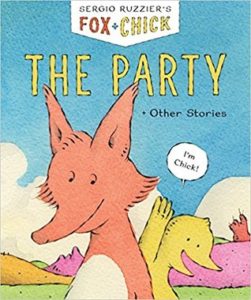Fox + Chick: The Party and Other Stories
Author and Illustrator: Sergio Ruzzier
Published April 17th, 2018 by Chronicle Books
Summary: Fox and Chick don’t always agree. But Fox and Chick are always friends. With sly humor and companionable warmth, Sergio Ruzzier deftly captures the adventures of these two seemingly opposite friends. The luminous watercolor images showcased in comic-book panel form will entice emerging readers, while the spare text and airiness of the images make this early chapter book accessible to a picture book audience as well.
Teachers’ Tools for Navigation: Activities for The Party and Other Stories include:
How to Read a Graphic Novel
Reading a graphic novel differs from reading prose text because readers must infer everything outside of the dialogue they are given and what is presented in the illustrations.
First, using Fox + Chick discuss the differences with your class between a picture book, a chapter book, and a graphic novel. Make sure to point out the parts of a graphic novel like speech bubbles show what the characters are saying, panels (each square), and the gutter (the space between panels). Then discuss how to read a graphic novel (typically read left to right, top to bottom).
Extension activity: Discuss with students why an author would choose to write their story as a graphic novel versus a chapter book or picture book.
Then, to show how inferences have to be made between panels, use pages 2/3 to page 4. As a reader you can infer that Chick continued walking to the house shown on page 2/3 even though the illustrations don’t show each little step. Also, between the first two panels on page 4, the reader can infer that Chick had to wait a bit even though the panels don’t show it.
After reading the story, have students show how they use inferring to comprehend the story by:
K-1st: Retell the story including inferences made between panels and what the illustrations show.
2nd-3rd: Rewrite the story as a narrative including inferences made between panels and what the illustrations show.
Conflict and Resolution
Conflict is the problem with a story or part of a story while the resolution is how that problem is solved. In each of the chapters in Fox + Chick, there is a conflict and a resolution. Each chapter gives an opportunity to learn these narrative elements.
For chapter 1, “The Party,” as a class, determine the conflict and the resolution.
For chapter 2, “Good Soup,” have students determine the conflict and resolution in pairs.
For chapter 3, “Sit Still,” have students determine the conflict and resolution independently.
Character Traits
Character traits are all the aspects of a character’s behavior from how they act to what they think.
Before reading: As a class, list the character traits the students assume a fox and a chick are going to have. How will they act? What type of personality will they have? How are they going to interact with each other?
After reading: Independently or as a class, have students complete a character trait activity on each character. Have students answer the following questions then place their answers into a graphic organizer:
How did the character act in the story?
What feelings did the character portray in the story?
What words would you use to describe the character’s personality?
See the Teaching Guide Created by me (Kellee) for even more activities and discussion questions!
You can also access the teaching guide through Chronicle’s website here.
Recommended For:




